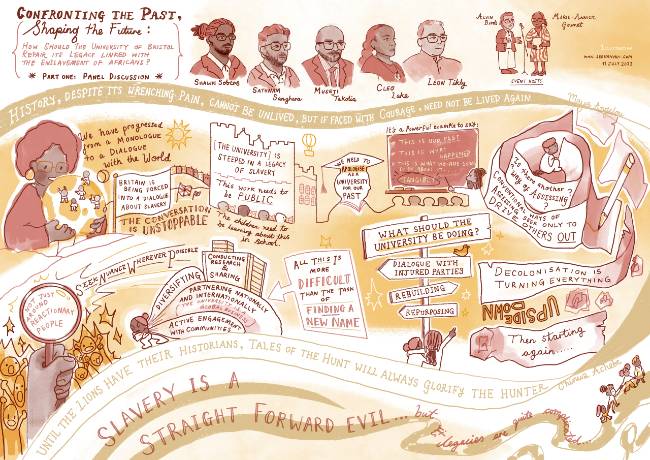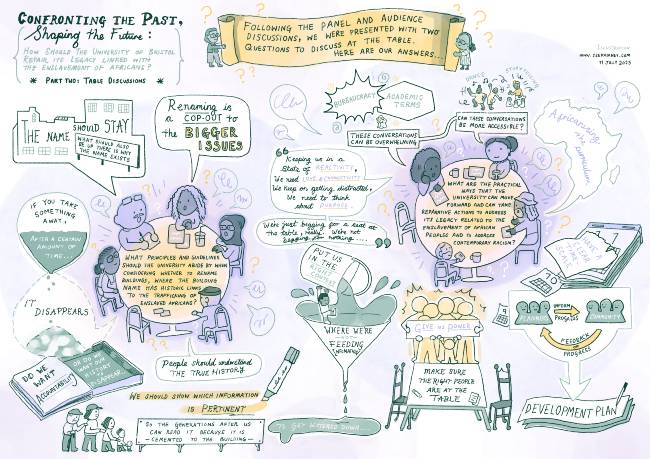Building names public consultation
What we did to understand our communities’ perceptions of our building names, and whether they should be changed.
In January 2020 the University commissioned research into its links to the transatlantic trafficking of enslaved African people. We published the findings of this research in November 2022 in the initial Legacies of Slavery report.
The report looked into the complex connections between our founding donors, Wills and Fry, as well as Colston and Goldney. These families all have buildings named after them across the university campus and three of whom are referenced in our logo.
However, the conversation about changing building names started before the research. From a student petition to change the name of the Wills Memorial Hall from 2017 we began to understand the feelings that some communities were having about these names.
On this page
- Why did we do the public consultation?
- What did the public consultation involve?
- What were the outcomes of the public consultation?
Why did we do the public consultation?
The Legacies of Slavery report called for a need to be transparent and to “...involve people within the university on the renaming of the buildings.”
The consultation plan emphasised the need to make sure that all voices were heard.
What did public consultation involve?
We launched the initial consultation as a survey as well as two hybrid events. The aim of the initial consultation was set out to explore our communities’ views on renaming our buildings.
The survey
The call for survey responses was published in local and national media. It was also shared with staff, students, alumni, and the wider Bristol community, and offered a mix of multiple choice and free text answers.
Most often data alone cannot tell us the motivations and strength of feeling of the respondents. But by getting both quantitative and qualitative data, we got a better understanding of their responses.
We had an overwhelming number of responses, with people sharing their views from across the globe.
Community events
The two hybrid community events included presentations of the Legacies of Slavery report, panel discussions, and reflections from the attendees. There was a mix of testimony from University staff and students, and with real-time comments from members of the wider community.
From the initial survey and two community events, we heard strong and polarised views on renaming. The resounding message we got from the respondents was that the most important question was not whether to rename buildings or not.
Instead it was the lack of commitment to address racism and the racial inequalities many of them experienced either during their time at the University or in the University’s relation with the wider community. They felt overlooked and not heard.
To learn more about the debates at the in-person events, you can watch some of the recordings.
Confronting the Past, Shaping the Future event
Looking at the percentage of survey respondents that came from racially minoritised backgrounds, it was very clear that this group was highly underrepresented. We extended the consultation timeline and hosted a community event at the Rose Green Centre called 'Confronting the Past, Shaping the Future'. For this event we specifically invited our racially minoritised communities to share their views and opinions of both the renaming and the wider reparative agenda.
Alvin Birdi and Marie-Annick Gournet hosted the event. Senior members of University staff also attended, including the Vice-Chancellor. The event began with a speech and panel discussion, and attendees were then invited to discuss specific questions at their tables.
Speech and panel discussion
Sathnam Sanghera, journalist and author of 'Empireland', gave a keynote speech and hosted the panel. The panel was made up of:
- Shawn Sobers (event chair), Professor in Cultural Interdisciplinary Practice at UWE
- Museji Takolia, Chair of Bristol's Commission on Race Equality (CoRE)
- Cleo Lake, artist and former Lord Mayor of Bristol (2018-2019)
- Leon Tikly, Professor of Education, University of Bristol.
Panel members also shared their thoughts.
Table discussion
We invited attendees to discuss two more questions in groups at their tables:
- What principles and guidelines should the University abide by when considering whether to rename buildings, where the building name has historic links to the transatlantic trafficking of enslaved African people?
- What are the practical ways that the University can move forward and can take reparative actions to address its legacy related to the enslavement of African peoples and to address contemporary racism?
Visual summary of the event
To create a visual summary of the event, we commissioned local artist Seekan Hui to create two illustrations. The illustrations capture the mood, some of the more well-known people, and include parts of conversations heard during the two parts of the event. They serve as a record of the event, and can be used as educational resources for discussions around these topics in the classroom.


What were the outcomes of the public consultation?
We had an overwhelming response to our survey and in-person events. And where people could not join, or felt they needed to expand on their responses, we received a number of replies directly via email.
- 3,670 survey responses with more than 14,600 free text answers from students (43%), staff (23%), alumni (17%), the Bristol public (10%), and people from outside Bristol (5.3%)
- 165 attendees at the two hybrid events
- 150 attendees at the event at the Rose Green Centre - mainly from racially minoritised communities
The views of the renaming were polarised as you can see from the Consultation and Engagement Report which analyses the results of the consultation.
There were several themes running through all responses regardless of background and ethnicity. These showed that the University should:
- provide more and better education about the University’s past
- work with communities on research to show real-life impact
- strengthen the University’s bond with the city and its people
- have a commitment to dialogue and allowing for community oversight.
There were very strong views on both sides of the debate about building renaming. However, there was one thing most of the respondents agreed on: that we need to do more to address racism and race inequality at the University.
From the consultation it was clear that building renaming is a complex topic, and we understand that not everyone will agree with our decision. But we cannot erase our connection to founders - even if that connection is uncomfortable. Because the more we know about our past the better equipped we are to change our future. The improvement of the lived experience for our racially minoritised staff, students, and communities is about more than changing building names. Using the University’s past as a catalyst for conversation, we want to create a more inclusive institution.
See what action we’re taking after listening to our communities.
Your questions answered
Answers to your questions about building names, the consultation, and the background.